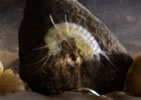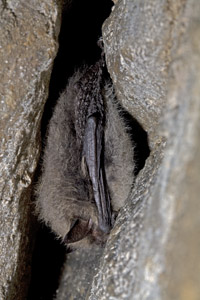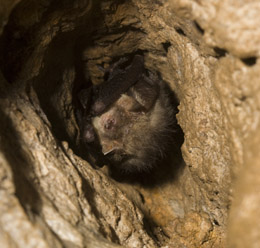Of the 16 species of British bat, nine species live in the Peak District, and five of these maker signifiacnt use of use underground sites: brown long-eared, Natterer’s, Daubenton’s, Brandt’s and whiskered bats. Another two species use the underground sites in summer (Daubenton's and Natterer's). They hibernate underground, typically from November to April. Unlike the Horseshoe bats that hang in the open cave, these bats mostly hide away in crevices, singly or in small groups, and are often overlooked.
During the summer (April-October) bats move around and have a selection of roosting sites, often old trees, buildings etc. They may use the caves as a night roost when feeding at this time and as a temporary day roost in bad weather. On autumn nights (August to October) hundreds of bats can ‘swarm’ at cave/mine entrances and below ground, with males competing to attract females and mate.
If food is scarce they sometimes go into torpor (controlled lowering of body temperature) much like a hibernating bat. An active bat will have a temperature of about 39 degrees and a heart beat of 1000 per minute. Bats eat large insects and typically live up to 15 years.
It is possible that thousands of bats use underground sites in the peak District but go unoticed by cavers.
HIBERNATING BATS
As autumn progresses the climate outside the cave becomes cooler and insects are less active, these means the bats cannot feed. Bats spend more time in torpor as food becomes scarce. They traditionally hibernate from October to late April as their food source (insects) disappears, but with warmer winters more insects are around and the hibernation period is becoming more irregular. In late autumn bats put on weight (not by eating more but by spending more time in torpor) so that their fat reserves will last them for up to five months of hibernation. Once a suitable hibernation site has been found (the air flow, humidity and temperature must be fairly constant – cooler than their summer roosting sites) they crawl into a crevice (only some species hang upside down). In caves they may be far underground where temperature varies little, but in a position where they are able to sense subtle changes in air temperature signifying changes outside. Heavy bats prefer warm roosts, skinny bats cooler roosts. Old wise bats regulate their temperature within a narrower band than youngsters and seem to roost singly.
In hibernation a bat may breathe once an hour, have a temperature as low as 2C, and a pulse of 10 per minute. Reducing its temperature means it uses less energy.
By November they may only wake when it is warmer and they can feed. Each day throughout hibernation the bats pulse rate slowly rises until it seems to make an unconscious decision (in mid afternoon) either to carry on raising its pulse and wake up, or allow it to drop again and return to hibernation. Every 10-15 days throughout winter they will wake to feed, urinate, just shuffle their feet, drink or fly off to roost somewhere else (up to 30 miles away). As winter moves by the bats fat reserves dwindle and they choose progressively colder roosts. In November they may go for a 12C roost, by March they prefer a 6C roost. In April they spend less time asleep and choose cool roosts close to feeding grounds, after digestion the bat allows its temperature to drop quickly.
If they are disturbed, they slowly wake up – 30 minutes after disturbance the heart rate will have gone from about 20 to 600 beats per minute and the body temperature from about 10C to 36C. This must use a surprising amount of energy, energy the bat cannot afford to use up unnecessarily as the valuable fat reserves are depleted with little hope of replenishment. Too many disturbances will mean that the fat reserves will not last the winter and they literally starve to death. In a state of hibernation bats are so torpid that they appear dead, but it takes very little to disturb them. Bats are quite specific on what temperature they want to hibernate at. Heat from cavers’ bodies will cause a rise in temperature which is detected by the bat. In a large or draughty passage this effect will be negligible, but in a small chamber or with a group of cavers the effect may be enough to rouse the bat. Heat generated by a caver is probably the most common cause of bat disturbance underground. Shining bright lights on the bat and the noise of a flashgun may be sufficient to wake it up.
Many bats in Britain are on the northern limit of their distribution - a small climate change could have major impacts.
Bat guano is important in the cave ecosystem, although in the northern caves it is rare to find a large bat roost and hence significant guano deposits. Bats eat half their weight in insects each day producing large amounts of nitrogen rich guano. This guano is food for beetles and other forms of cave life. Bats often carry parasites such as ticks, fleas and mites.
The Evening or VESPER BATS are a family that includes Pipestrelles and Myotis, these have a muzzle similar to a dog and prefer to hang against a surface like a wall or tree. These bats fold their wings alongside their bodies. The HORSESHOE BATS have a cone shaped nose leaf and hang by their hind feet with their wings wrapped around the body.
BATS IN UNDERGROUND SITES OF THE PEAK DISTRICT
Hibernating bats appear to prefer mines and caves where there is some draught. Many sites would be too warm for the bats without this draught. Undergound sites with multiple entrances, varying heights of passages and small crevices, and vegetation (particularly linear features) outside the entrance are preferred.
Myotis bats prefer to hibernate at temperatures between 2 and 5C. Myotis are the bats most likely to be seen swarming round cave entrances in autumn. Many Myotis bats hibernate in crevices including wriggling into loose scree/boulders – so a bat motionless by your feet might be hibernating, not dead! The Myotis bats found in caves are Natterer's, Daubenton's, Whiskered bats and Brandt's bat.
These are the bats you may see in the mines and caves of the Peak District:
Natterer's bats (Myotis nattereri) hibernate in caves, mines, cellars and tunnels, usually squeezed in a crack or crevice individually and in groups, although a few will hang in the open. They are widespread throughout Britain with about 70 000 in England. They hunt in dense vegetation by gleaning larger insects and spiders. In the Peak District Natterer's bats are occasionally recorded in underground sites in summer, these are maternity colonies.
Daubenton's bat (Myotis daubentoni) are also found throughout Britain with about 95 000 in England. They hibernate in crevices in caves, mines and tunnels, they are occasionally found hibernating on open walls and are found individually and in small groups. They hunt low over open water and so are found near such habitats. Daubenton's are generally found below 200m altitude. In the Peak District Daubenton's are also fairly regularly recorded in underground sites in summer, these are maternity colonies. They also hibernate in mines and caves in the Peak District.
Whiskered bats (Myotis mystacinus) are found in Britain as far north as the Firth of Forth. There are about 30 000 in England. They hibernate singly in caves on open walls and in crevices. Part of their diet is spiders.
The closely related Brandt's bat (Myotis brandti) appears to have similar habits to the Whiskered bat, there are around 20 000 in England. It is so closely related to the Whiskered bat that it is impossible to distinguish between the two (without DNA analysis), as the physical characteristics of the two species are variable and overlapping. Both species use caves and mines in the Peak District.
(The Alcathoe bat has recently been confirmed as living in the UK. It is very similar to Brandt's and Whiskered and so presumably can be found in caves. At present little is known about its status in the UK).
Brown long eared bats (Plecotus auritus) hunt in dense vegetation like woodland. It is widespread across Britain and probably our third most common bat after the two pipestrelles. They prefer cold places to hibernate and so will found near the entrances to caves. They are probably less dependant on caves than the previous species.
OTHER BATS
Noctule (Nyctalus noctula) – Britain’s largest bat, if you see a large bat flying in the open before dark it is probably a Noctule. They roost almost exclusively in tree holes in the UK but occasionally enter caves in autumn.
Leisler’s bat (Nyctalus leisleri) generally prefers holes in trees and buildings and does not often frequent caves, although might be found in crevices in winter. There are around 10 000 in England.
Pipistrelles Pipistrellus spp.are Britain’s most common bats but are rarely found in caves. There are three species of Pipistrelle the Common, Soprano and Nathusius’, which are very difficult to tell apart. The first two species might be found in caves, mines and tunnels in the winter. The soprano or ‘55’ is possibly more common the common or ‘45’ in the north of Britain. The numbers refer to the echolocation calls of the two bats. Pipistrelles seem relatively insensitive to variations of temperature when hibernating and so do not need to shelter in the warmer caves, unlike some other species. Nathusius’ pipistrelle hibernates in trees, cliffs and caves but seems to migrate to Europe to do this. If you see a small bat flying outside before dark it is probably a Pipistrelle.
Lesser horseshoe bats used to be found in the Peak District, and as they appear to be maintaining or increasing populations further south they may be rediscovered in this region.
BATS AND THE LAW
It is illegal to intentionally or recklessly disturb a bat while it is occupying a structure or place that it uses for shelter or protection. Under the Habitats Regulations it is an offence to deliberately disturb a bat (this applies anywhere, not just at its roost). If more than one bat is involved, the fine is £5,000 per bat.
Bat workers acknowledge the important help they get from cavers to know what is going on in the roosts and hibernacula’s used by bats that are inaccessible to non-cavers. Cavers can assist bat conservation groups by not disturbing the bats and by reporting their findings. See the Bat Conservation Trust for more information on bats.
OTHER MAMMALS
You may see evidence of badgers, foxes, otters, mink or rats using a cave entrance for shelter.
|



